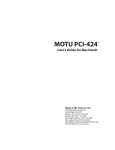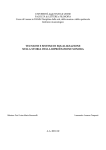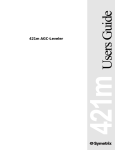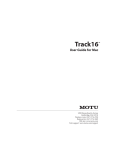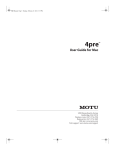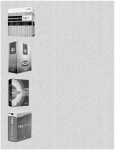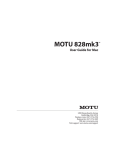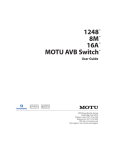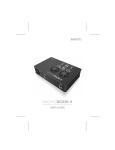Download MOTU PCI-424 User`s guide
Transcript
MOTU PCIe-424 ™ User’s Guide for Windows 1280 Massachusetts Avenue Cambridge, MA 02138 Business voice: (617) 576-2760 Business fax: (617) 576-3609 Technical support: (617) 576-3066 Tech support fax: (617) 354-3068 Tech support email: [email protected] Web site: www.motu.com SAFETY PRECAUTIONS AND ELECTRICAL REQUIREMENTS WARNING: TO REDUCE THE RISK OF FIRE OR ELECTRICAL SHOCK, DO NOT EXPOSE THIS APPLIANCE TO RAIN OR OTHER MOISTURE. CAUTION: TO REDUCE THE RISK OF ELECTRICAL SHOCK, DO NOT REMOVE COVER. NO USER-SERVICEABLE PARTS INSIDE. REFER SERVICING TO QUALIFIED SERVICE PERSONNEL. WARNING: DO NOT PERMIT FINGERS TO TOUCH THE TERMINALS OF PLUGS WHEN INSTALLING OR REMOVING THE PLUG TO OR FROM THE OUTLET. WARNING: IF NOT PROPERLY GROUNDED YOUR MOTU AUDIO INTERFACE COULD CAUSE AN ELECTRICAL SHOCK. Your MOTU audio interface is equipped with a three-conductor cord and grounding type plug which has a grounding prong, approved by Underwriters' Laboratories and the Canadian Standards Association. This plug requires a mating three-conductor grounded type outlet as shown in Figure A below. If the outlet you are planning to use for your MOTU audio interface is of the two prong type, DO NOT REMOVE OR ALTER THE GROUNDING PRONG IN ANY MANNER. Use an adapter as shown below and always connect the grounding lug to a known ground. It is recommended that you have a qualified electrician replace the TWO prong outlet with a properly grounded THREE prong outlet. An adapter as illustrated below in Figure B is available for connecting plugs to two-prong receptacles. Figure A Figure B Grounding lug Screw 3-prong plug Make sure this is connected to a known ground. 3-prong plug Grounding prong Two-prong receptacle Properly grounded 3-prong outlet Adapter WARNING:THE GREEN GROUNDING LUG EXTENDING FROM THE ADAPTER MUST BE CONNECTED TO A PERMANENT GROUND SUCH AS TO A PROPERLY GROUNDED OUTLET BOX. NOT ALL OUTLET BOXES ARE PROPERLY GROUNDED. If you are not sure that your outlet box is properly grounded, have it checked by a qualified electrician. NOTE: The adapter illustrated is for use only if you already have a properly grounded two-prong receptacle. Adapter is not allowed in Canada by the Canadian Electrical Code. Use only three wire extension cords which have three-prong grounding type plugs and three-prong receptacles which will accept your MOTU audio interface’s plug. IMPORTANT SAFEGUARDS 1. 2. 3. 4. 5. 6. 7. 8. Read instructions - All the safety and operating instructions should be read before operating your MOTU audio interface. Retain instructions - The safety instructions and owner's manual should be retained for future reference. Heed Warnings - All warnings on your MOTU audio interface and in the owner's manual should be adhered to. Follow Instructions - All operating and use instructions should be followed. Cleaning - Unplug your MOTU audio interface from the computer before cleaning and use a damp cloth. Do not use liquid or aerosol cleaners. Overloading - Do not overload wall outlets and extension cords as this can result in a risk of fire or electrical shock. Power Sources - This MOTU interface should be operated only from the type of power source indicated on the marking label. If you are not sure of the type of power supply to your location, consult your local power company. Power-Cord Protection - Power-supply cords should be routed so that they are not likely to be walked on or pinched by items placed upon or against them. Pay particular attention to cords and plugs, convenience receptacles, and the point where they exit from your MOTU audio interface. 9. Lightning - For added protection for your MOTU audio interface during a lightning storm, unplug it from the wall outlet.This will prevent damage to your MOTU audio interface due to lightning and power line surges. 10. Servicing - Do not attempt to service this MOTU interface yourself as opening or removing covers will expose you to dangerous voltage and other hazards. Refer all servicing to qualified service personnel. 11. Damage Requiring Service - Unplug your MOTU audio interface from the computer and refer servicing to qualified service personnel under the following conditions. a. When the power supply cord or plug is damaged. b. If liquid has been spilled or objects have fallen into your MOTU audio interface. c. If your MOTU audio interface has been exposed to rain or water. d. If your MOTU audio interface does not operate normally by following the operating instructions in the owner's manual. e. If your MOTU audio interface has been dropped or the cabinet has been damaged. f. When your MOTU audio interface exhibits a distinct change in performance, this indicates a need for service. 12. Replacement Parts - When replacement parts are required, be sure the service technician has used replacement parts specified by the manufacturer or have the same characteristics as the original part. Unauthorized substitutions may result in fire, electric shock or other hazards. 13. Safety Check - Upon completion of any service or repairs to this MOTU interface, ask the service technician to perform safety checks to determine that the product is in safe operating conditions. ENVIRONMENT Operating Temperature: 10°C to 40°C (50°F to 104°) AVOID THE HAZARDS OF ELECTRICAL SHOCK AND FIRE Do not handle the power cord with wet hands. Do not pull on the power cord when disconnecting it from an AC wall outlet. Grasp it by the plug. INPUT Line Voltage: 100 - 120 volts AC, RMS (US and Japan) or 220 - 250 volts AC, RMS (Europe). Frequency: 47 - 63 Hz single phase. Power: 7 watts maximum. CAUTION: DANGER OF EXPLOSION IF BATTERY IS REPLACED. REPLACE ONLY WITH THE SAME OR EQUIVALENT TYPE RECOMMENDED BYMANUFACTURER. DISPOSE OF USED BATTERY ACCORDING TO MANUFACTURER’S INSTRUCTIONS. Contents 5 6 10 Quick Reference: PCIe-424 Audio Card About the PCIe-424 System Packing List and PC System Requirements 11 Installing the PCIe-424 Hardware 13 Expanding Your PCIe-424 System 3 Mark of the Unicorn License Agreement and Limited Warranty on Software TO PERSONS WHO PURCHASE OR USE THIS PRODUCT: carefully read all the terms and conditions of this agreement before using this software package. Using this software package indicates your acceptance of the terms and conditions of this license agreement. Mark of the Unicorn, Inc. (“MOTU”) owns both this program and its documentation. Both the program and the documentation are protected under applicable copyright laws. Your right to use the program and the documentation are limited to the terms and conditions described herein. License YOU MAY: (a) use the enclosed program on a single computer; (b) physically transfer the program from one computer to another provided that the program is used on only one computer at a time and that you remove any copies of the program from the computer from which the program is being transferred; (c) make copies of the program solely for backup purposes.You must reproduce and include the copyright notice on a label on any backup copy. YOU MAY NOT: (a) distribute copies of the program or the documentation to others; (b) rent, lease or grant sublicenses or other rights to the program; (c) provide use of the program in a computer service business, network, time-sharing, multiple CPU or multiple user arrangement without the prior written consent of MOTU; (d) translate or otherwise alter the program or related documentation without the prior written consent of MOTU. Term Your license to use the program and documentation will automatically terminate if you fail to comply with the terms of this Agreement. If this license is terminated you agree to destroy all copies of the program and documentation. Limited Warranty MOTU warrants to the original licensee that the disk(s) on which the program is recorded be free from defects in materials and workmanship under normal use for a period of ninety (90) days from the date of purchase as evidenced by a copy of your receipt. If failure of the disk has resulted from accident, abuse or misapplication of the product, then MOTU shall have no responsibility to replace the disk(s) under this Limited Warranty. THIS LIMITED WARRANTY AND RIGHT OF REPLACEMENT IS IN LIEU OF, AND YOU HEREBY WAIVE, ANY AND ALL OTHER WARRANTIES, BOTH EXPRESS AND IMPLIED, INCLUDING BUT NOT LIMITED TO WARRANTIES OF MERCHANTABILITY AND FITNESS FOR A PARTICULAR PURPOSE. THE LIABILITY OF MOTU PURSUANT TO THIS LIMITED WARRANTY SHALL BE LIMITED TO THE REPLACEMENT OF THE DEFECTIVE DISK(S), AND IN NO EVENT SHALL MOTU BE LIABLE FOR INCIDENTAL OR CONSEQUENTIAL DAMAGES, INCLUDING BUT NOT LIMITED TO LOSS OF USE, LOSS OF PROFITS, LOSS OF DATA OR DATA BEING RENDERED INACCURATE, OR LOSSES SUSTAINED BY THIRD PARTIES EVEN IF MOTU HAS BEEN ADVISED OF THE POSSIBILITY OF SUCH DAMAGES. THIS WARRANTY GIVES YOU SPECIFIC LEGAL RIGHTS WHICH MAY VARY FROM STATE TO STATE. SOME STATES DO NOT ALLOW THE LIMITATION OR EXCLUSION OF LIABILITY FOR CONSEQUENTIAL DAMAGES, SO THE ABOVE LIMITATION MAY NOT APPLY TO YOU. Update Policy In order to be eligible to obtain updates of the program, you must complete and return the attached Mark of the Unicorn Purchaser Registration Card to MOTU. General This License Agreement shall be governed by the laws of the Commonwealth of Massachusetts and shall inure to the benefit of MOTU, its successors, administrators, heirs and assigns. Copyright Notice Copyright © 2006, 2005, 2004, 2003, 2002 by Mark of the Unicorn, Inc. All rights reserved. No part of this publication may be reproduced, transmitted, transcribed, stored in a retrieval system, or translated into any human or computer language, in any form or by any means whatsoever, without express written permission of Mark of the Unicorn, Inc., 1280 Massachusetts Avenue, Cambridge, MA, 02138, U.S.A. Limited Warranty on Hardware Mark of the Unicorn, Inc. and S&S Research (“MOTU/S&S”) warrant this equipment against defects in materials and workmanship for a period of NINETY (90) DAYS from the date of original retail purchase. This warranty applies only to hardware products; MOTU software is licensed and warranted pursuant to separate written statements. If you discover a defect, first write or call Mark of the Unicorn at (617) 576-2760 to obtain a Return Merchandise Authorization Number. No service will be performed on any product returned without prior authorization. MOTU will, at its option, repair or replace the product at no charge to you, provided you return it during the warranty period, with transportation charges prepaid, to Mark of the Unicorn, Inc., 1280 Massachusetts Avenue, MA 02138. You must use the product’s original packing material for in shipment, and insure the shipment for the value of the product. Please include your name, address, telephone number, a description of the problem, and the original, dated bill of sale with the returned unit and print the Return Merchandise Authorization Number on the outside of the box below the shipping address. This warranty does not apply if the equipment has been damaged by accident, abuse, misuse, or misapplication; has been modified without the written permission of MOTU, or if the product serial number has been removed or defaced. ALL IMPLIED WARRANTIES, INCLUDING IMPLIED WARRANTIES OF MERCHANTABILITY AND FITNESS FOR A PARTICULAR PURPOSE, ARE LIMITED IN DURATION TO NINETY (90) DAYS FROM THE DATE OF THE ORIGINAL RETAIL PURCHASE OF THIS PRODUCT. THE WARRANTY AND REMEDIES SET FORTH ABOVE ARE EXCLUSIVE AND IN LIEU OF ALL OTHERS, ORAL OR WRITTEN, EXPRESS OR IMPLIED. No MOTU/S&S dealer, agent, or employee is authorized to make any modification, extension, or addition to this warranty. MOTU/S&S ARE NOT RESPONSIBLE FOR SPECIAL, INCIDENTAL, OR CONSEQUENTIAL DAMAGES RESULTING FROM ANY BREACH OF WARRANTY, OR UNDER ANY LEGAL THEORY, INCLUDING LOST PROFITS, DOWNTIME, GOODWILL, DAMAGE OR REPLACEMENT OF EQUIPMENT AND PROPERTY AND COST OF RECOVERING REPROGRAMMING, OR REPRODUCING ANY PROGRAM OR DATA STORED IN OR USED WITH MOTU/S&S PRODUCTS. Some states do not allow the exclusion or limitation of implied warranties or liability for incidental or consequential damages, so the above limitation or exclusion may not apply to you. This warranty gives you specific legal rights, and you may have other rights which vary from state to state. MOTU, AudioDesk and Mark of the Unicorn are trademarks of Mark of the Unicorn, Inc. This equipment has been type tested and found to comply with the limits for a class B digital device, pursuant to Part 15 of the FCC Rules. These limits are designed to provide reasonable protection against harmful interference in a residential installation. This equipment generates, uses, and can radiate radio frequency energy and, if not installed and used in accordance with the instruction manual, may cause harmful interference to radio communications. However, there is no guarantee that interference will not occur in a particular installation. If this equipment does cause interference to radio or television equipment reception, which can be determined by turning the equipment off and on, the user is encouraged to try to correct the interference by any combination of the following measures: • Relocate or reorient the receiving antenna • Increase the separation between the equipment and the receiver • Plug the equipment into an outlet on a circuit different from that to which the receiver is connected If necessary, you can consult a dealer or experienced radio/television technician for additional assistance. PLEASE NOTE: only equipment certified to comply with Class B (computer input/output devices, terminals, printers, etc.) should be attached to this equipment, and it must have shielded interface cables in order to comply with the Class B FCC limits on RF emissions. WARNING: changes or modifications to this unit not expressly approved by the party responsible for compliance could void the user's authority to operate the equipment. Quick Reference: PCIe-424 Audio Card Connect additional MOTU PCI audio interfaces here. You can connect up to four I/Os to a PCIe-424 card for a maximum of 96 possible active inputs and outputs. Connect the first (core system) interface to the PCIe-424 card here using the Audio Wire cable included with your core system. If you use a custom cable, it should not be longer than 50 feet. If you are using the PCIe-424 system with one or more ADATs, or any other ADAT Sync-compatible recorder, use this standard ADAT SYNC INPUT to connect the PCIe-424 card to the end of your ADAT sync chain. For example, if you have three ADATs, chain the ADATs in the usual fashion (SYNC OUT to SYNC IN, etc.), and then connect the last ADAT’s SYNC OUT to this SYNC IN on the PCIe-424 card. This connection allows you to make sample-accurate audio transfers between your host audio software (if it supports sample-accurate sync) and the ADATs. If you have a MIDI Timepiece AV or a Digital Timepiece, make it the master of the ADAT SYNC chain so that you can control everything from your host audio software (or your other MIDI Machine Control compatible software). 5 CHAPTER 1 About the PCIe-424 System OVERVIEW The PCIe-424 core system is a computer-based hard disk recording system for Mac OS and Windows that offers 24 simultaneous inputs and outputs per Audio Wire cable, expandable to 96 inputs/outputs. A core system consists of a PCI card connected to a standard 19-inch, single-space, rack-mountable audio interface. The system includes AudioDesk™, full-featured audio workstation software for Mac OS that supports both 16-bit and 24-bit recording at any standard sample rate up to 192 kHz. For Windows, a WDM driver is included for compatibility with audio applications that support standard multi-channel WDM and Wave drivers. Also included is an ASIO driver for multi-channel operation with Steinberg Cubase and other ASIO-compatible software. The PCIe-424 card . . . . . . . . . . . . . . . . . . . . . . . . . . . . . . . . . . 6 The 2408mk3 interface . . . . . . . . . . . . . . . . . . . . . . . . . . . . . . 7 The 24I/O interface . . . . . . . . . . . . . . . . . . . . . . . . . . . . . . . . . 8 The HD192 interface . . . . . . . . . . . . . . . . . . . . . . . . . . . . . . . . 8 16-bit and 24-bit recording. . . . . . . . . . . . . . . . . . . . . . . . . . . 9 AudioDesk . . . . . . . . . . . . . . . . . . . . . . . . . . . . . . . . . . . . . . . . . 9 Digital Performer . . . . . . . . . . . . . . . . . . . . . . . . . . . . . . . . . . . 9 Other Audio Software . . . . . . . . . . . . . . . . . . . . . . . . . . . . . . . 9 A computer-based system . . . . . . . . . . . . . . . . . . . . . . . . . . . . 9 THE PCIE-424 CARD A PCIe-424 core system ships with a single PCI audio card called the PCIe-424. The card features a custom processor, a powerful DSP chip, four 6-pin Audio Wire connectors and an ADAT SYNC IN connector. High definition audio The PCIe-424 system can operate at the following high sample rates: 44.1, 48, 88.2, 96, 176.4 and 192 kHz. All MOTU PCIe-424 audio interfaces support rates up to 96 kHz. In addition, the HD192 interface offers analog recording and playback at 176.4 or 192 kHz. Audio Wire expansion The PCIe-424 card provides four Audio Wire jacks, which are used to attach MOTU PCI audio interfaces to the card installed in the computer. Each Audio Wire is capable of transmitting 24 simultaneous channels of 96 kHz digital audio input and output or 12 simultaneous channels of 192 kHz input and output. Up to four MOTU PCI audio interfaces can be connected to a single PCIe-424 card for a maximum of 96 possible input and output connections. All MOTU PCI audio interfaces (including the 2408mk3, 24I/O and HD192) can also be “mixed and matched” on the PCIe-424 card, along with legacy interfaces, such as the 2408, 2408mII, 1296, 1224, 24i and 308. Audio Wire carries a proprietary communication protocol between the card and the external I/O to handle the extremely low latencies required by the system. The heart of the PCIe-424 card is a custom-programmed VLSI chip capable of simultaneously processing all 96 inputs and outputs (192 channels total) at samples rates up to 96 KHz. At 176.4 or 192 kHz, this chip can process 48 simultaneous channels of input and output. The custom chip handles all of the system’s I/O processing, freeing up the host computer’s processing bandwidth for real-time DSP effects and hard disk I/O. CueMIx DSP The PCIe-424 card features CueMix DSP™, a flexible DSP-driven mixing and monitoring matrix that provides the same near-zero monitoring latency as today’s latest digital mixers. CueMix DSP™ allows you to connect keyboards, synth modules, drum machines, and even effects processors and then monitor these live inputs with no audible delay and no processor drain on the host computer’s CPU. The CueMix DSP engine resides on the PCIe-424 card, so it works across all interfaces connected to the card. The included CueMix Console software provides an on-screen mixer that gives you hands-on control of your monitor mix, regardless of what audio software you prefer to use. Digital Performer users have the additional option of controlling CueMix DSP directly within Digital Performer’s mixing environment. CueMix DSP completely eliminates the buffer latency associated with monitoring on host-based recording systems. Sample-accurate synchronization The PCIe-424 card’s standard 9-pin ADAT SYNC IN connector provides sample-accurate synchronization with all ADATs or other ADAT Sync-compatible devices connected to the system. For example, if you digitally 6 ABOUT THE PCIE-424 SYSTEM transfer a single track of material from the ADAT via light pipe into the 2408mk3’s Macintosh workstation software, and then transfer the track back to the ADAT, it will be recorded exactly at its original location, down to the sample. Analog bank The analog inputs are equipped with 24-bit, 96 kHz 64x oversampling A/D converters. The analog outputs have 24-bit, 96 kHz 128x oversampling D/A converters. Video and SMPTE time code synchronization The entire PCIe-424 system, including all connected interfaces, can resolve directly to SMPTE time being received on any analog input in the system. In addition, the 2408mk3 interface provides a BNC video input for resolving the entire system directly to video. The entire analog section of the circuit board inside the 2408mk3 is physically isolated from the rest of the board to help ensure quiet analog performance. THE 2408MK3 INTERFACE Each of the 2408mk3’s eight analog stereo input pairs can be switched between -10 dB and +4 dB operating levels to support a wide variety of input sources, including synths, samplers and other equipment. Main Outs For main stereo output, analog outputs 1 and 2 are duplicated on the rear panel as a stereo pair of balanced, +4dB quarter-inch TRS jacks. A dedicated knob on the front panel gives you volume control of the main outs. 24 simultaneous inputs and outputs The 2408mk3 I/O is a single-space, rack mountable chassis with gold-plated analog and digital audio connectors on its rear panel and status LEDs on the front. The rear panel has seven banks of 8-channel I/O at 44.1 or 48 kHz in the following formats: ■ One bank of 8 balanced (+4 dB) analog quarter-inch (TRS) inputs and outputs. ■ Three Tascam DA-88 ‘TDIF’ 8-channel digital I/O connectors. ■ Three Alesis ADAT optical ‘light pipe’ 8-channel digital I/O connectors. Three banks of 8-channel I/O at 44.1/48 kHz Internally, the 2408mk3 has three 8-channel I/O busses (A, B and C) for a total of 24 simultaneous inputs and outputs at 44.1 or 48 kHz. Using the included console software (available for both Mac and PC), you can freely choose any I/O format for each bank. For example, you can choose analog for Bank A, ADAT optical for Bank B, and Tascam TDIF for Bank C. Or you can choose ADAT optical for all three banks. Three banks of 4-channel digital I/O at 88.2/96 At 88.2 or 96 kHz, the 2408mk3 interface offers 4 channels of I/O per bank for the ADAT optical and Tascam TDIF formats, along with 8 channels of 96 kHz analog input and output. Therefore, the 2408mk3 interface offers a maximum of 16 channels of input and output at 96 kHz (2 banks of 4-channel digital I/O plus 8 channels of analog I/O). The maximum number of digital inputs and outputs at 96 kHz is 12 (3 banks of 4-channel I/O). SPDIF The 2408mk3 rear panel has three SPDIF stereo pairs. The SPDIF output on the right is dedicated to duplicating the stereo main out so that you can, for example, conveniently record a stereo mix to your DAT deck without swapping cables with other SPDIF devices. The other two SPDIF connectors serve as independent stereo inputs/outputs. They can be used with any SPDIF compatible device, such as an effects processor or other device. Word Clock BNC Word clock connectors (in and out) are provided for synchronization with standard word clock devices. Via software, the word output can be made to either double or halve the 2408mk3’s system word rate. For example, if the 2408mk3 is running at 96 kHz, it can generate 48 kHz word clock output. Video sync The BNC input connector can be switched via software to become a dedicated video input, allow you to slave your PCIe-424 system to NTSC or PAL/SECAM video (or blackburst) without a dedicated synchronizer. The PCIe-424 card provides a DSP-driven phase-lock engine with sophisticated filtering that provides fast lockup times and sub-frame accuracy. SMPTE time code The RCA jacks for SPDIF input/output can be switched via software to become a dedicated SMPTE time code (LTC) input and output, allowing you to slave your PCIe-424 system to time code and/or generate time code. If you prefer to use them for SPDIF digital I/O, you can use any analog 7 ABOUT THE PCIE-424 SYSTEM input to receive SMPTE time code. Any active channel, digital or analog, can be chosen as a SMPTE time code output. Level Meters The front panel of the 2408mk3 I/O displays several banks of status LEDs. On the left are three banks of eight LEDs (A, B and C) that show audio signal on the 2408mk3’s three ADAT/TDIF digital I/O buses. On the right are eight vertical, five-segment LEDs that show input level from the eight analog inputs measured from -40 dB to 0 dB. A similar bank of dedicated five-segment LEDs is provided for the analog outputs. These LEDs also provide status information, such as the system clock sample rate and other settings. Stand-alone Format Conversion Finally, several additional LEDs, along with accompanying set/select buttons, allow you to access the 2408mk3 I/O’s stand-alone format conversion features. With these controls, you can bounce any I/O format to any other format without a computer. Headphone output The 2408mk3 front panel includes a quarter-inch stereo headphone output jack and volume knob. The headphone output matches the main stereo outs, which have their own volume knob. THE 24I/O INTERFACE 24 analog 24-bit/96 kHz inputs and outputs The 24I/O is a single-space, rack mountable chassis with gold-plated analog audio connectors on its rear panel and level meters on the front. The rear panel has 24 gold-plated, balanced +4dB TRS analog inputs and outputs with 24-bit A/D converters. All inputs and outputs can be accessed simultaneously. Internally, the 24I/O has a 24-bit data path to and from the computer so that all audio data is carried to/from the computer in 24 bits. Converters All analog-to-digital and digital-to-analog inputs on the 24I/O are equipped with 24-bit, 128x oversampling, extremely high-quality, latest-generation converters. Level Meters The front panel of the 24I/O displays 48 level meters, arranged in three banks of 8 channels. For each channel, there is a five-segment meter that measures from -42 dB to 0 dB. The clock section in the middle of the front panel indicates the current sample rate. THE HD192 INTERFACE High definition audio recording The HD192 provides the very best A/D and D/A conversion available. It can operate at any standard sample rate from 44.1 kHz to 192 kHz. 12 analog inputs and 12 outputs The HD192 I/O is a two-space, rack mountable chassis with XLR audio connectors on its rear panel and level meters on the front. The rear panel has four banks of I/O in the following formats: ■ One bank of 12 XLR inputs ■ One bank of 12 XLR outputs ■ One pair of AES/EBU stereo digital I/O connectors All analog inputs and outputs can be accessed simultaneously. AES/EBU digital I/O The HD192 rear panel includes an AES/EBU stereo digital input and output. Both of these connectors are capable of handling 24-bit digital audio at sample rates up to 96 kHz. The AES/EBU input and output each has its own independent sample rate converter for real-time conversion between any two sample rates between 40 and 100 kHz. System word clock in and out BNC ‘System’ Word clock connectors (in and out) are provided for synchronizing the HD192’s main system clock with other standard word clock devices. Word clock in and out BNC Word clock connector can be programmed via software for either input or output for synchronization with standard word clock devices. 8 ABOUT THE PCIE-424 SYSTEM AES word clock in A BNC Word clock input connector is provided for independently synchronizing the AES/EBU output of the HD192 to a standard input clock. Level Meters The front panel of the HD192 I/O displays several banks of status LEDs. On the right are two banks of meters for the twelve analog inputs and twelve analog outputs. For each channel, there is a 19-segment meter that measures from -42 dB to 0 dB, along with two red ‘over’ lights. The top LED remains illuminated after clipping occurs until it is cleared via software (either manually or via a configurable time-out period). The red LED below it only lights momentarily when clipping. The Clock section on the left displays the current system clock setting (44.1, 48, 88.2, 96, 176.4, 192 or no clock), as well as the AES/EBU clock setting if sample rate conversion is taking place independently of the system clock. 16-BIT AND 24-BIT RECORDING The PCIe-424 system handles all data with a 24-bit signal path, regardless of the I/O format. Using AudioDesk™, the PCIe-424 system’s Macintosh workstation software (included), you can record and play back 16-bit or 24-bit audio files at 44.1, 48, 88.2 or 96 kHz via any of the system’s analog or digital inputs and outputs. The HD192 also offers recording at 176.4 or 192 kHz. On Windows, 24-bit audio files can be recorded with any compatible host application that supports 24-bit recording. OTHER AUDIO SOFTWARE The PCIe-424 system ships with a standard WDM driver that allows you to record, edit, play back and mix your projects using your favorite WDM- and Wave-compatible Windows software. The PCIe-424 system also ships with standard Mac OS audio drivers. The PCIe-424 also includes an ASIO driver for multi-channel compatibility with Steinberg Cubase and other ASIO-compatible software. A COMPUTER-BASED SYSTEM Regardless of what software you use with the PCIe-424 system, the host computer determines the number of tracks the software can record and play simultaneously, as well as the amount of real-time effects processing you can apply to your mix. A faster computer with more RAM and faster hard drives will allow more simultaneous tracks and real-time effects than a slower computer with less RAM and slower hard drives. Standard third-party system acceleration products can also help you achieve higher track counts. AUDIODESK AudioDesk is a full-featured, 24-bit audio workstation software package for Macintosh included with each PCIe-424 core system. AudioDesk provides multi-channel waveform editing, automated virtual mixing, graphic editing of ramp automation, real-time effects plug-ins with 32-bit floating point processing, crossfades, support for many third-party audio plug-ins (in the MOTU Audio System plug-in format), background processing of file-based operations, sample-accurate editing and placement of audio, and more. DIGITAL PERFORMER The PCIe-424 system is fully integrated with MOTU’s award-winning Digital Performer audio sequencer software package. 9 ABOUT THE PCIE-424 SYSTEM CHAPTER 2 Packing List and PC System Requirements PACKING LIST PC SYSTEM REQUIREMENTS A MOTU PCIe-424 core system ships with the items listed below. If any of these items are not present in your core system box when you first open it, please immediately contact your dealer. The PCIe-424 system requires the following PC system: ■ One rack-mountable audio interface (2408mk3, 24I/O or HD192) ■ At least 128 MB (megabytes) of RAM (512 MB or more is recommended) ■ A 800 MHz Pentium CPU or faster ■ A Pentium III or faster is recommended ■ One PCIe-424 audio card ■ One available PCIe (PCI Express) slot ■ One 15-foot “Audio Wire” cable ■ Windows XP ■ Power cord PLEASE REGISTER TODAY! ■ One PCIe-424 Mac/Windows “flip book” manual ■ One AudioDesk Manual (for Mac OS only) Please register your PCIe-424 system today. There are two ways to register. ■ One cross-platform CD-ROM ■ Product registration card ■ Visit www.motu.com to register online OR ■ Fill out and mail the included product registration card As a registered user, you will be eligible to receive on-line technical support email and announcements about product enhancements as soon as they become available. Only registered users receive these special update notices, so please, complete and mail this registration card! Thank you for taking the time to register your new MOTU products! 10 PACKING LIST AND PC SYSTEM REQUIREMENTS CHAPTER 3 Installing the PCIe-424 Hardware OVERVIEW Install the PCIe-424 software first! . . . . . . . . . . . . . . . . . . . 11 Install the PCIe-424 audio card . . . . . . . . . . . . . . . . . . . . . . 11 Connect the audio interface . . . . . . . . . . . . . . . . . . . . . . . . . 12 INSTALL THE PCIE-424 SOFTWARE FIRST! We recommend that you install the PCIe-424 software before installing the PCIe-424 card itself. If you’ve already installed the card, you might want to temporarily remove it to install the software, and then put it back in after installing the PCIe-424 software. INSTALL THE PCIE-424 AUDIO CARD 1 Switch off and unplug your computer. ☛ Failure to do so may result in serious shock or injury. 2 Open your computer. 6 Remove the PCIe-424 card from its anti-static bag. 7 Gently but firmly insert the card into any available PCIe slot. 8 Secure the bulkhead of the PCIe-424 card to the computer chassis with the bolt from the slot cover. ☛ We strongly recommend securing the PCIe-424 card in this manner. Doing so allows you to ensure secure connections to the card later on in the installation. 3 Find an available PCIe slot. 4 Remove the slot cover, if necessary. 5 Before removing the PCIe-424 card from it’s anti-static bag, touch the power supply inside your computer to discharge any static electricity that may have built up on you. 9 Place the cover back on your computer. 10 Reconnect the power cord to the computer before proceeding. 11 INSTALLING THE PCIE-424 HARDWARE CONNECT THE AUDIO INTERFACE 1 Plug one end of the Audio Wire cable (included) into the Audio Wire socket next to the 9-Pin ADAT Sync connector on the PCIe-424 card as shown below in Figure 3-1. 2 Plug the other end of the Audio Wire cable into the audio interface as shown below in Figure 3-1. Step 1 Connect the Audio Wire to the socket closest to the ADAT SYNC port. Step 2 2408mk3 interface 24I/O interface HD192 interface Figure 3-1: Connecting the audio interface to the PCIe-424 audio card. 12 INSTALLING THE PCIE-424 HARDWARE CHAPTER 4 Expanding Your PCIe-424 System OVERVIEW CONNECTING EXPANSION INTERFACES Up to four MOTU PCI audio interfaces can be connected to a single PCIe-424 card for up to 96 simultaneously active inputs and outputs. For example, if you connect four 2408mk3 interfaces, you get a total of 232 and 248 physical input and output connections (respectively) and up to 96 input and output channels. You can freely “mix and match” any MOTU PCI audio interfaces together on a single PCIe-424 card, including the 24I/O, HD192, 2408, 2408mkII, 1296, 1224, 24i and 308 models. Connect expansion interfaces to the three available Audio Wire sockets on your core system’s PCIe-424 card as shown below in Figure 4-1. The PCIe-424 card, with its CueMix DSP engine, ties all connected audio interfaces together, allowing them to act as a massive audio routing matrix for mixing, merging, splitting and routing to/from all connected inputs and outputs. Interface #4 Interface #3 Interface #2 MOTU PCI audio interfaces are sold separately as expanders for any MOTU core system. See your MOTU dealer for details. Connecting expansion interfaces . . . . . . . . . . . . . . . . . . . . 13 Multiple interfaces in the Console. . . . . . . . . . . . . . . . . . . . 13 Enabling banks, or individual ins and outs . . . . . . . . . . . . 13 Working with input and output menus . . . . . . . . . . . . . . . 14 CueMix DSP routing among interfaces . . . . . . . . . . . . . . . 14 Core system interface (#1) Figure 4-1: You can connect up to four MOTU PCI audio interfaces to a single PCIe-424 card. MULTIPLE INTERFACES IN THE CONSOLE The MOTU PCI Audio Console window displays the settings for one PCIe-424 interface at a time. To choose which I/O you are looking at, choose it from the Configure Interface menu as shown below in Figure 4-2. Synchronizing multiple interfaces . . . . . . . . . . . . . . . . . . . 14 Word clock connections are not necessary . . . . . . . . . . . . 14 Sample rate issues . . . . . . . . . . . . . . . . . . . . . . . . . . . . . . . . . . 14 Figure 4-2: Choosing which audio interface you are working with in the MOTU PCI Audio Console window. Enabling banks, or individual ins and outs Bank enabling, or enabling individual inputs and outputs, works the same for each interface in the MOTU PCI Audio Console window. Choose an interface from the Configure Interface menu (Figure 4-2) and then configure the banks (or individual outputs) as usual. 13 EXPANDING YOUR PCIE-424 SYSTEM outputs. You can route any input to any output, create multiple mix busses and mix inputs to outputs across all interfaces. SYNCHRONIZING MULTIPLE INTERFACES The entire PCIe-424 system gets its clock from whatever you choose from the Clock Source menu in the MOTU PCI Audio Console window. Synchronization across all connected interfaces is sample-accurate. All available sync sources on all connected interfaces are displayed in the menu as demonstrated below in Figure 4-4. Working with input and output menus With multiple interfaces connected, input and output menus show all available ports on all interfaces, as demonstrated below in Figure 4-3. If interfaces are configured to share the same type of I/O format (analog, for example), their outputs are labeled with the bank letter (A, B or C) and interface name, along with numbered suffixes (e.g. 2408mk3-1, 2408mk3-2, etc.) according to the order in which they are connected to the PCIe-424 card as shown in Figure 4-1 on page 13. 2408mk3 #1 2408mk3 #2 Figure 4-4: The entire PCIe-424 system can be clocked from any sync source on any connected interface. After you choose a source from this menu, the entire system, including all connected interfaces, synchronizes to it with sample-accurate precision. This example shows three 2408mk3 interfaces and one 24I/O interface. Word clock connections are not necessary Each MOTU PCI audio interface in the system gets its clock from the Audio Wire cable connection to the PCIe-424 card (unless it is the master clock itself). There is no need to make word clock connections between interfaces. SAMPLE RATE ISSUES 2408mk3 #3 While the PCIe-424 card can operate at sample rates as high as 192 kHz, not all MOTU PCI audio interfaces support the higher rates. When choosing high sample rates (above 48 kHz) interfaces that do not support the rate will be temporarily taken off line by the system. 24I/O (on Audio Wire port #4) Figure 4-3: Input and output menus show the ports of all connected interfaces. In this example, there are three 2408mk3 interfaces and one 24I/O interface. CUEMIX DSP ROUTING AMONG INTERFACES The PCIe-424 card, with its CueMix DSP engine, ties all connected audio interfaces together, allowing them to act as a massive audio routing matrix for mixing, merging, splitting and routing to/from all connected inputs and 14 EXPANDING YOUR PCIE-424 SYSTEM














